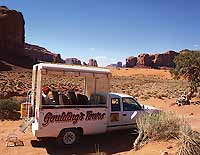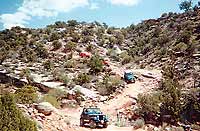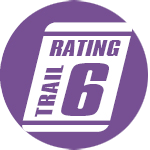Motorized HAPPENINGS Octobre 2018 |
|||
| Strike Ravine - Trail Rating 6 | |||
|
|||
|
|||
Monument Valley Tours: Navajo guided on Horseback or 4WD |
|||
Monument Valley’s towering sandstone buttes climb up to 1,000 feet like skyscrapers rising up from the desert floor. The red-sand park straddles the Utah-Arizona border and is best accessed by US Hwy 163. East and West Mittens, along with Merrick Butte, are the park’s famous steeply buttes that form a visual triangle. East and West Mittens received their names because when observed from the south, the buttes appear like mittens with the thumbs pointed inwards. The Mitten buttes act as doorways to the valley with Merrick Butte as the sentinel to the park.  These buttes and Monument Valley’s size and beauty cause visitors to flock to region. At almost 92,000 acres, the sandstone formations, rock arches and spires are better viewed as part of a guided tour. These tours are highly recommended to see Monument Valley, learn about its movie history, and better understand and interpret the rich and unique culture of the Navajo Nation. There are a variety of guided tours in many different modes of transportation available in Monument Valley. For those seeking a bit more adventure, four-wheel drive vehicle tours and horseback tours are available. Short durations or long adventure tours are available including all-day, sunset, full moon, overnight and multiple day tours. Private and customizable tours are also options. Visitors who prefer to drive their own vehicle can explore the park on their own, but only a Navajo guide can take visitors beyond the 17-mile scenic loop. Visitors will pass 11 scenic viewpoints on tours along Valley Drive. These scenic backdrops provide great photo opportunities and tours allow ample time to take photos. A point of note, visitors to the park are advised to ask for consent before photographing any of the Navajo people, their homes or possessions. A fee is usually requested in exchange for the photography. .jpg) Some visitors forgo the vehicles to explore the backcountry on horseback. The Navajo people consider horses an integral part of their culture. Tour horses are trained to accept riders of all levels. Sunrise and sunset horseback tours allow riders views of the valley with the changing sunlight. Sunset and sunrise tours are exceptional because of the various shades of crimson hues across the valley. Some visitors forgo the vehicles to explore the backcountry on horseback. The Navajo people consider horses an integral part of their culture. Tour horses are trained to accept riders of all levels. Sunrise and sunset horseback tours allow riders views of the valley with the changing sunlight. Sunset and sunrise tours are exceptional because of the various shades of crimson hues across the valley. For nighttime photographers and amateur astronomers, moonlight tours of the park are available. The new moon phase is better to experience the Milky Way and silhouetted buttes and mesas. The entrance fee for Monument Valley is $20 per vehicle for up to four people. If more than four people are in the vehicle there is an additional $6 per person fee. Tour prices range from $40 and up. Excursions are offered daily and can be arranged online, over the phone or booked in person. Tour operators are available in the parking lot at the visitor center, and from Goulding’s Lodge. It doesn’t take long for visitors to Monument Valley to understand why John Wayne once remarked: “So this is where God put the West”. To learn more about the area tours and to book a Monument Valley Tour, visit utahscanyoncountry.com |
 This trail enters an area that remains beautiful despite the marks of “range improvements”, power lines, and uranium mining. Today, grazing continues, the power lines hum, but the mines are in ruins. Four-wheeling gets better, however, as the mine roads deteriorate. The trail is about 12 miles south of Moab and between Highway 191 and the La Sal Mountains. Much of it is in and about Pole Canyon and other headwaters of Kane Springs Canyon. One badly eroded trail portion crosses a tributary canyon that we are calling Strike Ravine for the outcrop of a tilted sandstone layer that forms the base of the trail.
This trail enters an area that remains beautiful despite the marks of “range improvements”, power lines, and uranium mining. Today, grazing continues, the power lines hum, but the mines are in ruins. Four-wheeling gets better, however, as the mine roads deteriorate. The trail is about 12 miles south of Moab and between Highway 191 and the La Sal Mountains. Much of it is in and about Pole Canyon and other headwaters of Kane Springs Canyon. One badly eroded trail portion crosses a tributary canyon that we are calling Strike Ravine for the outcrop of a tilted sandstone layer that forms the base of the trail. Trails are difficult with considerable erosion damage, loose rocks, dirt, and slickrock. Water in excess of 12” is possible with mud conditions. Steps not exceeding 36”. 4WD, tall tires (33” plus) with two traction adding devices (lockers, limited slips) are required. A winch would be a plus. Enhanced suspension travel and good ground clearance are a required. Excellent driving skills are recommended.
Trails are difficult with considerable erosion damage, loose rocks, dirt, and slickrock. Water in excess of 12” is possible with mud conditions. Steps not exceeding 36”. 4WD, tall tires (33” plus) with two traction adding devices (lockers, limited slips) are required. A winch would be a plus. Enhanced suspension travel and good ground clearance are a required. Excellent driving skills are recommended.